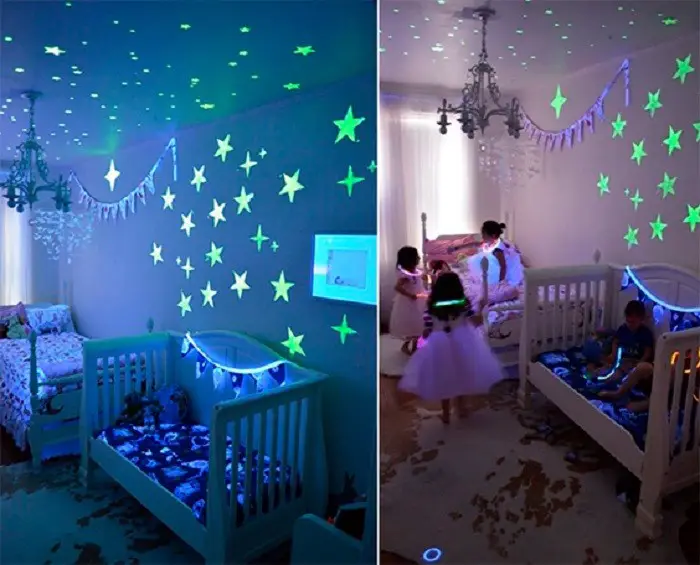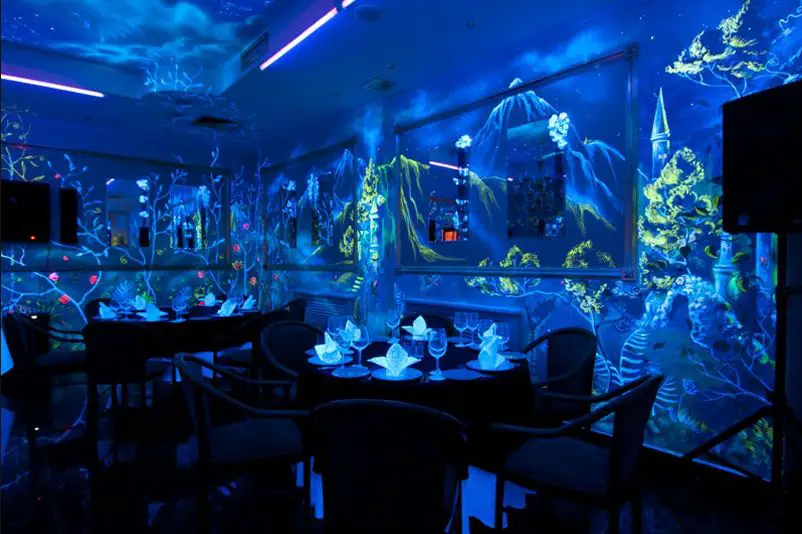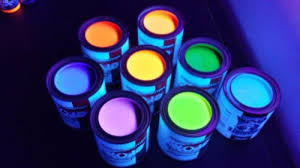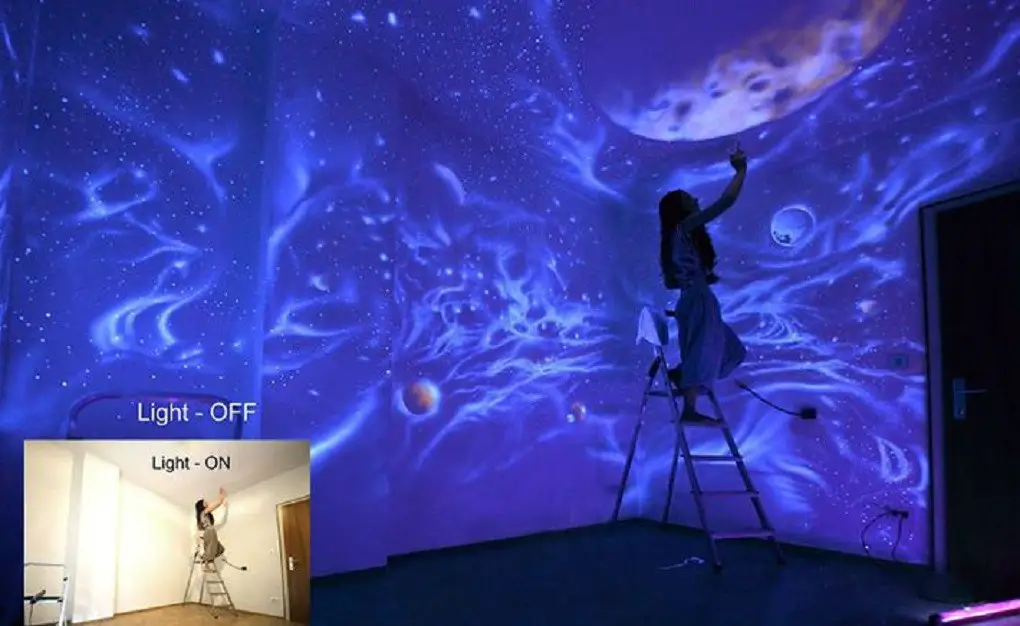Glow In The Dark Paint for Walls: these colors really shine!
Glow in the dark paint for rooms. Maybe you are planning a DIY in your walls with Glow In The Dark Paint? When I started my first small project with colors that glowed at night, I didn’t know much about afterglow colors, daylight colors, and had never worked with such colors.
I chose the wrong color several times and sold myself several times. The color just didn’t glow. I paid a lot of tuition. To give you a little insight into the jungle of afterglow colors or daylight colors, you will find all my findings summarized here as compactly as possible. Although – compact is very, very difficult with the wealth of information.
The Difference Between Fluorescent Paint
First of all, you have to be clear about the fluorescent color you want to buy because there are colors that shine by themselves at night, and colors only shine under black light.
What is an afterglow color?

Afterglow color is a color that stores incident light and emits it again with a time delay. This is called phosphorescence and means the property of a substance to continue to glow in the dark after being illuminated. Because of this property, by the way, it is correctly called not afterglow color but afterglow color.
The disadvantage of luminous paint is that it has to be heavily charged with light and, depending on the quality, persists for different lengths of time. The luminosity decreases continuously. Excellent color quality is crucial for afterglow colors!.
Phosphorescent Paint: What To Look For
Phosphorescent paint is paint that glows when it has been exposed to light. We explain what to look for when buying and using such paint.
What Should You Consider When Buying Phosphorescent Paint?
Phosphorescent paint is also called afterglow paint and has the property of glowing in the dark after being illuminated with light. There are a few things to consider when buying the color to achieve a long afterglow.
- The excellent quality of the afterglow color is necessary because the color requires a lot of light irradiation to continue to glow, and depending on the variety, it can persist for different lengths of time.
- Like other colors, the afterglow colors consist of the combination of pigments with a binder. The pigment can be either alkaline earth aluminate or zinc sulfite. Alkaline earth aluminate glows much longer than zinc sulfite.
- The ingredients are often not specified in the colors. Paints that contain alkaline earth aluminate as a pigment, however, are usually significantly more expensive than those with zinc sulfite.
- Incidentally, afterglow paints are not radioactive: in the past, self-luminous substances were used for the colors, but they have been banned since the early 2000s.
What Should You Pay Attention To When Using The Color?

Regardless of whether the color used is a fluorescent or a standard color, a certain amount of caution is always required.
- Colored solvents can always be flammable and harmful, and can cause symptoms such as headache, nausea, or fatigue.
- When using afterglow paint that is not shown as body color, you should wear disposable gloves. If the paint is used in the form of spray paint, a mask should protect the airways.
- If furniture or other objects are painted with afterglow paint, this should always happen outside or only in well-ventilated rooms.
- Always pay attention to the intended use, which the manufacturer specifies on the color: There are unique fluorescent colors for the skin or those that can be used as make-up and do not cause irritation. At the same time, some colors should only be used for objects.
Quality and luminosity – the ingredients are crucial.
Afterglow colors, like all colors, consist of pigments combined with a binder. Alkaline earth aluminate or zinc sulfite can be added to the paint as a pigment. At this point, we speak of the quality of the colors. Alkaline earth aluminates shine longer than zinc sulfite! They are also much more expensive and valuable.
Unfortunately, the ingredients are not listed in online shops. Even with the products I received, there were no ingredients on the product!
The cheaper option, zinc sulfite, was definitely used for products that lose their luminosity after just a few minutes. When I made my first purchases, I received precisely these colors and was very disappointed with the luminosity.
Is afterglow paint radioactive?
This question is not so far-fetched. In the past, self-luminous substances based on radium or later on tritium were produced and used, for example, as illuminants for clock hands. Radium-containing fluorescent paints were used on a large scale in the military. This time is not as long ago as you might think. The problem was only recognized and averted in the early 2000s. Radioactive substances for fluorescent paints are now prohibited.
Making phosphorescent home paint
Ingredients for fluorescent paint

First, you have to choose the type of paint you want to make: water or oil or solvent-based. The one that is diluted in water is more versatile, and you could use it on any base from plastics, to fabric, glass or cardboard, to walls or furniture. Also, since it does not have chemical components, it is softer, less harmful, and safer to use at home.
- The paint type you prefer.
- Phosphorescent pigments.
Where to buy and how to choose the ingredients?
Paint warehouses and DIY specialty stores have both base paint and pigments so you can make your paint of this type and let your creativity run wild. Also, stores specializing in craft supplies and art paint may have these types of ingredients.
- The pigments have to be waterproof in the case of water-based paint and not waterproof if you use solvents.
- There are seven degrees of phosphorescence: zero being the one that gives the most significant effect and seven the least.
- Pigments with the thickest grain are brighter, but it’s important to note that it can make the paint too grainy and difficult to apply.
- There are different colors of luminous pigments, although keep in mind that green is the purest and the one that gives you more luminosity under black light.
- The base paint you choose must not contain UV filters, or the fluorescent effect will not be as expected.
- Dense and transparent dyes are recommended for mixing with this type of pigment, and it is possible to find specific base paints for this use with which an optimal result is achieved.
Step by step to make the painting
Attention if you have opted for painting with solvents or similar components, handling requires much more care and attention. Only adults can make this mixture and use it. Therefore, avoid this type of dye with children and bet better on edible paints.
If you have chosen water paints, it is not a children’s paint, although it is less aggressive, older children can help you prepare and paint, but with supervision and caution.
- Put the base paint in a suitable container of sufficient size.
- Add the pigments and stir vigorously until completely dissolved.
- The most recommended average dose is 1000 grams of paint for every 200 grams of pigment.
- Prepare the right amount of dye you need.
- It will only be valid between half and 2 hours after it has been mixed, heed the manufacturer’s advice.
Some ideas for using phosphorescent paint at home
On the wall
The fluorine touch is ideal on the walls and ceilings of the bedrooms; they shine and give them a significant bit of originality. The hallways are also great for making creatives with paint that shines at night.
If you decide to paint with phosphorescent in the living room, the floor is a very innovative destination, but it will give you incredible results. Try painting geometric rugs – it simulates with the paint directly on the floor – that will only cover the space at night.
In decorative elements
Jewelry boxes, photo frames, paper flowers. Are ideal elements to paint with this type of enamel that is seen under black light. Even pieces like cups, vases, or flowerpots are an excellent option.
Pictures or photos
Artistic paintings to which details or areas are added – for example, sky, sea, stars. – become magical and mysterious, during the day they have an appearance, and at night they change to offer other details.
The photographs can also decorate and personalize with this type of paint. You discover fun details and messages or items such as hearts or stars when there is no light.
How To Make Glow In The Dark Paint Without Uv Light
It is easier than it seems to be. You just need to follow a series of steps. As for the materials you need, we will highlight them in bold.
- Fluorescent powder. Just get one of these little bottles online or at a craft store. There are many colors and various types.
- Paint pot. If you want it not to alter the fluorescent powder’s color, buy, for example, acrylic gel. But watch out! If the paint is oily, use conventional cosmetics; if it is watery, coated.
- Let’s mix! Take a small bowl or cup and mix the powder and paint at a ratio of 1/5. Then stir the mixture until it is homogeneous.
Alternative Method
In addition to this method, you have another alternative. It consists of taking the felt from one of those fluorescent markers, mixing it with water, and with cornmeal. This method is undoubtedly perfect for small decorative tasks. The main reason is that the brilliance of the paint will be much less.
If you use the first method, you can apply it to all kinds of objects. However, keep one thing in mind: its duration is limited. Perhaps the brightness will remain for a few hours. In case you need its effect to last, you shouldn’t make the paint yourself. For that, below, we tell you.
Where To Find The Paint With The Best Value For Money
The answer is always the same, and you already know it: on the Internet. Just go to Amazon or AliExpress and use the search engine. However, it is usual that you do not have the necessary search filters to avoid being buried under the avalanche of results. So, below, we give you several examples of excellent products in terms of value for money.
What Is Fluorescent Paint?
Color that glows in the dark under black light is called fluorescent color. Fluorescent paint reacts to UV light. Through a photophysical process (fluorescence), she converts the UV light into a healthy glow. The effect ends as soon as UV light is no longer available. There is no afterglow.
These colors need UV light to glow in the dark. In simple terms, black light is UV light that emits no visible, at least no bright light. Therefore, it is very suitable for stimulating fluorescent paint. When using fluorescent daylight, an investment in blacklight lamps is always necessary.
The advantage of fluorescent luminescent paint is that it always shines with the same intensity when UV light is present. The color does not become paler during the night; the luminosity does not decrease.
The colors are intense neon colors. When lighting with black light, there is also the effect that white objects shine. Daylight color, in combination with a black sun, is therefore particularly suitable for parties.
I will not test fluorescent colors in the following: why? Simply because all fluorescent colors that develop under black light have so far delivered 1A results. All the colors were great. In my opinion, this is simply not worth an article.

